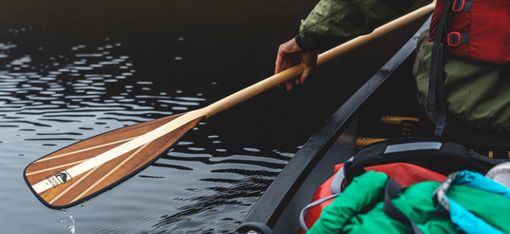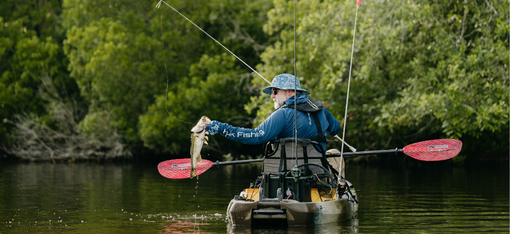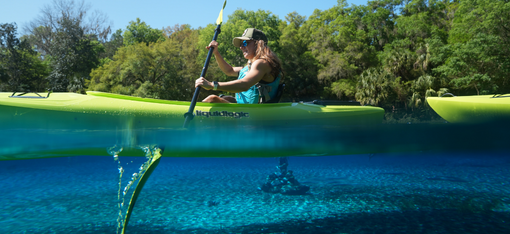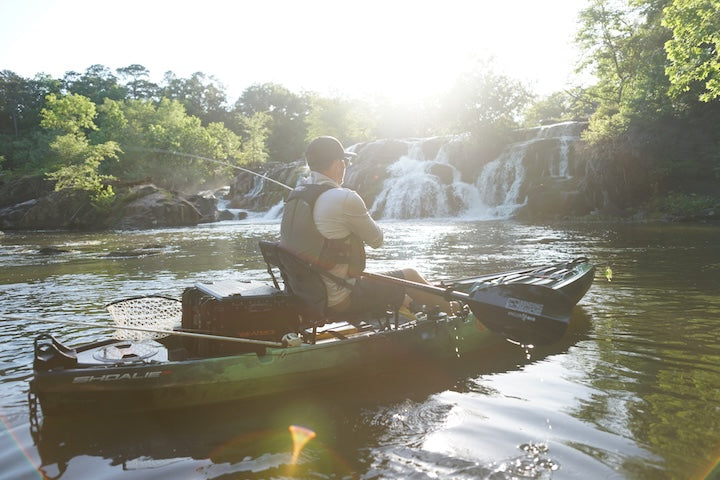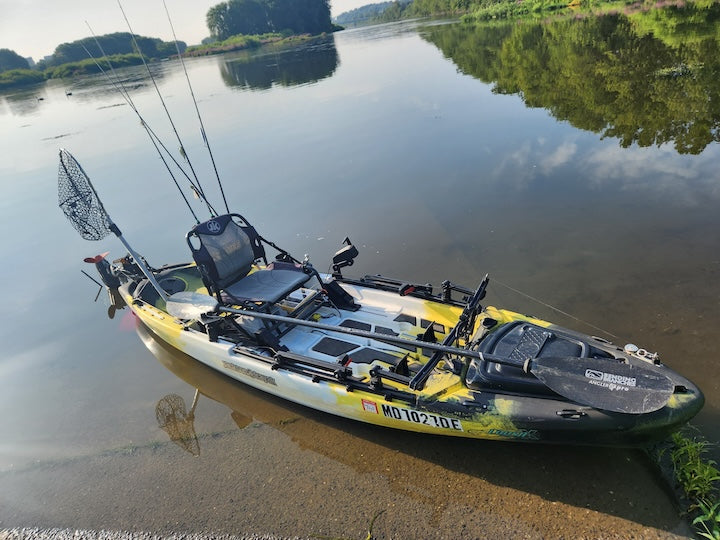It's Never Too Late to Start Paddling
10-minute read
By Mikaela Ferguson
A Dream to Paddle the Nahanni River
A few years ago my dad vocalized that he’d always wanted to paddle the Nahanni River.
He’d done a little canoe tripping in his youth, like a few weekend trips to Algonquin Provincial Park with friends in his twenties. The big trip he reminisced about was a five-day canoe trip on the Moose River when he was a Boy Scout. But at this point, it had been almost 40 years since he’d held a paddle.
I had a different path. I started canoeing when I was seven years old after my dad (and my mom) signed me up for summer camp. I kept at it, eventually becoming a camp counsellor and then a canoe guide.
One summer, I was getting ready to take a group of students along the Moose River. This is when my dad started telling me more and more about his time canoe tripping. He talked about the put-in under the bridge, exploring the town of Moosonee and a ride on the Polar Bear Express. He remembered the wide river, gravel bar campsites and bothersome mosquitos.
He also confessed he’d one day like to paddle the Nahanni River.

The Nahanni River
I didn’t appreciate how serious he was about paddling the river, so at the time I didn’t think much of it. I went on with my summer of canoe guiding and then started working in the “real world”. I did a few personal trips here and there, but my dad and I didn’t talk about canoeing much after that.
A few years later, when COVID-19 restrictions cancelled our family vacation and kept us from travelling, he brought up canoe tripping again. The Nahanni River was still on his mind, and he wondered what he’d need to do to prepare for such an adventure.
By this point, I recognized how serious he was about paddling the Nahanni, so I got planning. I researched rivers, comparing their whitewater level with the amount of driving required. I considered guided vs self-guided options. I was looking at a good intro-to-whitewater river.
Getting Back in the Canoe
Eventually, I settled on a guided trip on the Petawawa River. We’d also be taking my brother and we didn’t have all of the gear, so a guided trip made the most sense. We said goodbye to my mom, drove up to Algonquin Provincial Park, met up with the group and loaded our canoes.
So, after almost 40 years, my dad got back in a canoe and took his first paddling stroke.
The three of us had a great time on the Petawawa River. My brother and I shared a canoe and my dad sat at the bow of the guide’s boat. We paddled every rapid and none of us tipped. There were great campsites, great food and great company. We left the Petawawa River satisfied and hungry for more whitewater.
Even on the drive home, my dad talked about what river we could do next year and how much more practice he’d need before the Nahanni. Back to researching, I went.

Selfie on the Petawawa River
Learning to Stern
The next summer, he and I paddled the East Branch of the Spanish River. This time he sat in the stern and I called out paddling instructions from the front of the boat. It was a little rocky at first (due to low water and a lack of coordination). But over the week he got the hang of controlling the boat and I got the hang of, well, not controlling.
Later that summer, my dad took it a notch further. I was working which meant I couldn’t join him on another trip, so my brother went instead. Since my brother had even less whitewater experience, my dad was needed in the stern and he steered their canoe down the Dumoine River.
In all honesty, I was nervous to hear my dad had planned to paddle the Dumoine River, especially without me. The Dumoine is a big step up from the Petawawa or the Spanish River. The rapids have higher gradients and more volume; there are a lot of Class III rapids.
And yet my dad steered their canoe down beautifully. He and my brother paddled nearly every rapid and only tipped once (and it wasn’t even during a rapid, my dad laments). They had the support of the guides to help them find “the line” and provide safety, but it was the two of them that paddled down the rapid.
I seriously underestimated what my dad was capable of.

My dad steering us down a long rapid on the Spanish River
Onto the Nahanni
Now, we’ve got the Nahanni River on the calendar. Actually, we had it on the calendar last year but COVID delays extended further than we expected. We’re delayed yet another summer because of my work schedule, but we do have solid plans to paddle the Nahanni.
In the meantime, my dad is looking for other rivers to paddle so he can keep building his skills. He even has a new whitewater paddle to test out!

After the Dumoine, my dad is keen for an even bigger challenge
Getting Started in Canoeing
I get asked a lot of questions about how someone can get started in canoeing.
Some of the questions come from people who like the outdoors and want to try canoeing, but never did it as a kid and have no idea where to get started. Others, like my dad, canoed a little bit as a kid but it’s been decades since they held a paddle.
In most cases, there are concerns about learning the skills, staying safe and having the physical ability to do the trip.
I don’t think my Dad’s story is a recipe that needs to be followed. He happened to have a canoe guide as a daughter and we had the resources to start with a guided trip.
But I do think it can be a source of inspiration for anyone hoping to get into canoeing. It takes a lot of courage to learn a new skill at 60 years old, and I do believe anyone can pick up canoeing at any stage of their life. So below I’ve included some tips to help you get started canoeing.

Paddlers on the Spanish River
Take a Paddling Lesson
There are hundreds of outfitters, instructors and co-ops offering paddling lessons. You can choose a guided multi-day trip, a weekend course with an organization or an individual lesson with an instructor.
One thing I like about courses and individual lessons is that there is more of an emphasis placed on the mechanics and technique of paddling. Many guided trips don’t spend a lot of time going over the different strokes and how to do canoe-over-canoe rescues, while a course or lesson will teach you those exact skills. That will make you more prepared when you go out on your own.
Join a Canoeing Community
Try to find some canoeing buddies in your area. This can be really intimidating if you’re brand new. It’s true that most experienced canoeists don’t want to paddle with completely new paddlers. But you still have options.
For example, you can use Facebook Groups to find other new paddlers and plan a simple day trip at a provincial, state or national park. There are also canoeing clubs that host events and workshops. I’m part of the Wilderness Canoe Association and they host outings for paddlers of all skills. I’ve found these trips helpful even for myself, as I’ve learned a ton of more experienced paddlers.

My dad and I paddling down a rapid on the Spanish River
Take Extra Safety Considerations
As a new paddler, there are some things you should be aware of. I don’t say these things to scare anyone off canoeing, but I want to ensure anyone reading this post has the knowledge they need to stay safe on the water.
- Always wear your life jacket.
- Only paddle in warm temperatures when you’re new. Cold water can be deadly - stick to paddling in the summer for now.
- Only paddle on nice days. When you’re starting, don’t go out paddling when there is high wind or a storm brewing.
- Avoid big lakes and coastlines. Another tip for new paddlers is to avoid areas with big water. Stick to small lakes so you can easily get to shore.
- Avoid paddling alone. As a new canoeist, you’re probably not skilled in the art of solo canoe-over-canoe rescues, so a tip by yourself could prove quite problematic. Canoe with someone else or in a group until you’ve built up your skills.
- Carry a satellite communication device. When you’re in the backcountry, it’s a good idea to always carry a communication device that isn’t reliant on cell towers. These can be pricey, but a lot of outfitters and outdoor retailers will have rental options.
- Carry an extra paddle. Just in case you lose your paddle (I’ve lost mine!) carry a space paddle on your canoe trip.
- Start small and work your way up. For your first few canoe trips, plan a short route in a well-travelled area. It can help, both mentally and physically, to only be a few kilometers away from your car. Less time on the water means less time for something to go wrong, and you can always turn back if you need to.
- Have fun and get out there! At the end of the day, the only way to get started is to… get started! However you can - whether it’s through a guide, instructor, community event or something else - try to get out for at least a day paddle. Once you start paddling, you’ll quickly realize how intuitive it is.
Getting started in whitewater canoeing is a little different, and I’ve gone into further detail in this post.
What are you waiting for?
I hope this story has inspired you to get into a canoe, even if it’s your first time. Paddling is a great activity for people of all ages, and once you get over the initial learning curve, you’ll be able to plan some awesome trips in the backcountry.
As always, if you have any questions about getting started, send me a message.
Happy adventuring!
Mikaela is the voice behind Voyageur Tripper, an outdoor blog that aims to teach people how to take longer and more challenging trips in the backcountry. She previously worked as a wilderness guide, leading canoeing and hiking trips in Ontario, Quebec and Nunavut. Mikaela currently lives on the West Coast. You can find her on Instagram at @voyageurtripper.

Do you have paddle questions our friendly Customer Service Team can help you with today? Contact them: 715-755-3405 • [email protected]
More for you...




